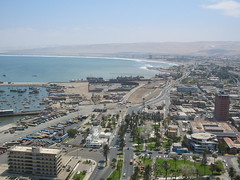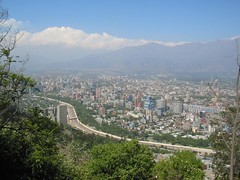The landscape, a few hours north of Santiago de Chile, slowly begins to change. There appear the first signs of the Atacama Desert, which occupies a huge part of the north of Chile. Chañaral is a town that lies on the Pacific coast where the border between the sea and the desert begins to be clear. Don Hugo was an indefatigable man of the sea, which at maturity has invented an innovative way to survive and at the same time to provide jobs for many of his fellow citizens, just taking advantage of the particular climatic conditions of the Chilean coast. In fact, in Chañaral drought begins to be a problem, but the high temperature range between day and night, the proximity to the ocean and the conformation of the hilly area, make possible that every morning on the city passes a thick blanket of wet fog. Don Hugo has invented a system of sheets that trap moisture and cause it to condense into water. An ingenious system of collection, channeling, and depressurization of the liquid allows to transport the water 800 meters down the hill, where there are some houses and plantations. Each day the system is able to generate about 5000 liters of drinking water. On the night we head to Antofagasta, the last big city before entering the desert, and finally in the region of Chilean mines. Father Hurtado, a well known Jesuit saint, a practical and hard worker man friend of working people and Chilean miners, watches over this underwater world.
Chile on the road
The bus station in Santiago of Chile is one of those places where time is suspended between the heat and the coolness of the night. When from any bus appears a new face, this immediately triggers a sudden excitement, typical of those little tricks of daily living. The bus station is always a fork in the journey of endless choices. After a brief consultation to decide whether to continue the travel toward the green and southern Switzerland, toward Concepcion and the legendary University of Bio Bio, toward Puerto Montt and his project of sustainable city (district heating, heat pumps especially from Baumann technology and an innovative composting system for organic waste through the work of earthworms), we decided to turn our eyes toward the north to the Atacama Desert. We leave Santiago slowly, hampered by a colorful procession of malabaristas, street artists who protest against the ban to exercise their art in the streets of downtown Santiago. We meet to party and discuss in the typical Peñas, places where you can listen and dance some cuecas of Violeta Parra and Victor Jara’s ballads, perhaps accompanied by delicious empanadas, pastel de choclo with humitas and Chilean wine. The meeting is for the next day in front of La Moneda, the historic headquarter of the Chilean president. Place where you will find all the protests of the country, a symbol of the military coup that overthrew Allende in 1973 and led to the long dictatorship of Pinochet.
From Valparaiso the Pan-American highway runs fast alongside the Pacific Ocean, the coast is interrupted by infrequent fishing villages, the coast is bent by the majestic power of the ocean. Distant to be seen, Easter Island lies at the mercy of the currents. In the bus we travel with a young Chilean family, a young woman with three small children, all beautiful. We talk about each other’s differences and we think, a gulf seems to divide us, but then we take a break for lunch on the road and they order a large plate of fries, which they call chorillana, with a huge glass of cola. The world nowadays is liquid, perhaps even more than predicted by Bauman at the dawn of the digital age.
Time bank in Santiago de Chile
In Santiago de Chile operates a time bank. Unlike a traditional bank, here is not worth the moneyand, what customers have in their accounts are favors and services. Plumbing, electrical, fashion, makeup, food, guitar lessons, animation or nursing are some of the services that can be exchanged by the residents of the neighborhoods in which the bank operates. According to the proponents of this initiative, the goal is to promote solidarity and citizens’ participation. Six times a month Flora cuts the hair of some of his neighbors. Doing so builds up the time that is repaid off with other favors from his neighbors, experts in other activities. People are paid with a check of the time bank as soon as they perform a favor. The time bank operates within the dynamics of the neighborhood and neighbors are those who administer it. The community participates because it understands that the bank of time is an effective way to improve the quality of life of the community in which the bank grows. In the time bank are fully applied the principles of equality and all work performed by residents of the neighborhood are considered as the same.
The Bank seeks to replace the individualism with cooperation in which what counts is the ability of people, not the time itself or money.
Santiago is named after St. James the Apostle, patron of the city. Born in Bethsaida, was the brother of John the Evangelist and son of Zebedee and Salome. He was with Jesus in the Garden of Olives, and distinguished himself, along with John, for his animosity.
Santiago de Chile: poetry, recycling, arts
Santiago de Chile, a small hotel for travelers run by an indigenous Mapuche, skyscrapers and crumbling houses. From the hill overlooking the city, as a kind of ordeal, you can enjoy a 360 degree view of the capital city, long and endless. Sometimes hidden behind the clouds, the Andes are majestic and snow-capped, in the background you can see the white paradise of Tres Valles and Valle Nevado, the ski resorts that are located only 50 kilometers from Santiago de Chile. The bustling center takes attention away from the phenomena of creative and marginalized life of the vast majority of the population. In the north of Santiago is located a huge landfill where most of the waste of the city is collected. The people who live there have earned the nickname of moscas, in the evocative dialect of Chile. They brave daily fortune, rising with great agility on each garbage truck that arrives at the landfill and they recover valuable pieces such as iron, copper, aluminum, bicycles and any material that can then be recycled or sold on the black market. Another example of creative adaptation is represented here by Don Ignacio, an intelligent man of about fifty years, who completely dedicated to retrieve pieces of wood, glass and metal at the landfill over the last twenty ones. His only goal, brilliantly achieved, was to build a abusive house with the scraps, equipped with every comfort and a strong and personal sense of aesthetics. The city is alive and looks at arts and poetry. The birth of the murales in Chile as a mass phenomenon, dates back to the 1969, at the time of protests against the Vietnam war, From the port of Valparaíso to Santiago de Chile, a few guys repainted the entire pathway of the protests by stopping at each rock along the road with an old Jeep. The Chilean group of murales is called the brigadas Ramona Parra and was born with the aim of achieving the candidacy of Salvador Allende in the propaganda of 1970. The urban murales are made of symbols and letters. The dove, hands, ears, the stars were a new language that has long been popular in the underground of the night.
Through the window Brazil, Argentina, Chile
From the airplane window, a long prelude begins when breaking the monotonous blue line of the ocean appears the sensual green and gold shape of Brazil, an outpost of the South American continent. It will be like a tape rewind live in the future, when we will be immersed in the journey. Dazzle the eyes observing these endless lands. The plane heads quickly towards the south, the colors of the austral spring appear where the Rio de la Plata hugely plunges into the Atlantic Ocean, separating Uruguay from the big sister Argentina. Buenos Aires appears, boundless. Underfoot the ground is dry and disconnected, rising announces the show of the Andes, the amazing mountain range that divides Argentina and Chile The shape of Aconcagua, the highest peak in America with its 6962 meters (22,841 feet) above sea level, hides the sun, but not the first glimpses of bucolic valleys of central Chile, surrounded by the first spring blooms. Further on, the Pacific Ocean rests agitated by powerful waves like mountains.
Santiago de Chile looks like a long strip that stretches from north to south, sometimes unformed, a small copy of the entire Chile, with its characteristic threadlike shape. So deeply varied and contradictory. Santiago is alive and pulsating.


